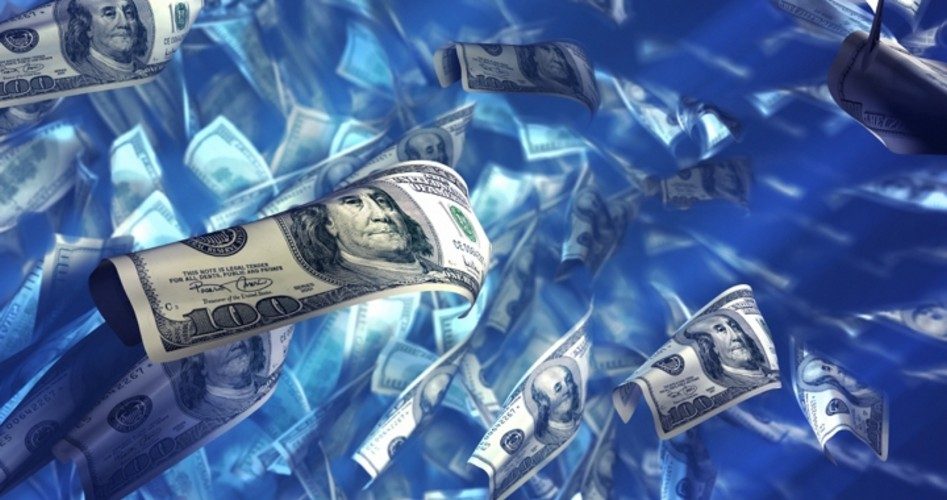
The government of the United States will soon borrow up to $1 trillion in order that it can continue making payments on the national debt, which totals nearly $22 trillion.
The U.S. Treasury Department announced it would issue new bonds and notes in order to fleece the American taxpayer for the funds it needs just to keep the debt bubble from bursting. Here’s how Bloomberg explained the scheme:
The total amount of 3-, 10- and 30-year securities to be offered at next week’s refunding auctions is seen by most at $84 billion. While that’s $1 billion more than the total for these maturities three months ago, that’s only because the size of the three-year sale was already nudged higher in December. A heightened supply of Treasury securities follows tax cuts and government spending increases implemented under the current administration. That’s darkening a fiscal outlook already made worrisome by rising entitlement-program expenses and higher costs to service America’s nearly $16 trillion in debt. The Federal Reserve’s balance-sheet runoff is also adding to supply, forcing Treasury Secretary Steven Mnuchin to tap the public for more funding.
Anyone reading the preceding paragraph will instantly identify the causes of the looming catastrophe. It is now as it was some 2,200 years ago when the Greek historian Polybius declared that “it is not hard to foretell the future by inference from the past.”
By seeking to soak Americans into financing a debt that was incurred by the creation of a leviathan that destroys the liberties and property of Americans, coupled with a crippling tax that penalizes prosperity, the U.S. Treasury is demonstrating that it — and by extension the federal government it finances — has nothing in common with the people and is simply surfeiting itself and the class of banksters that benefit from the betrayal.
It isn’t as if we weren’t warned. Beyond the warnings provided by the study of history, many of our own statesmen have foretold a future where paper money, central banking, and a bloated central government would combine to decimate the the freedom and the wealth of the American people.
Take, for example, the painfully prescient words of one of our forgotten heroes, John Taylor of Caroline, who wrote in 1814:
Swindled out of endless wealth, by the vauntings of paper credit, of its will and ability to defend liberty and property; that hapless nation sees itself taxed and impressed, to increase the penalty of its own credulity, [65] and to protect that which promised to yield protection; its annual taxes beget annual additions to permanent debt, and its endless war with France was commenced by the fears of its paper system, however this war may have gradually changed its ground.
The effect of opposite interests, one enriched by and governing the other, correctly follows its cause. One interest is a tyrant, the other its slave.
And, later in that same essay, he accurately describes the eventual effect of the unholy alliance of paper money, bloated bureaucracy funded by debt, and crony capitalism:
Whatever destroys an unity of interest between a government and a nation, infallibly produces oppression and hatred. Human conception is unable to invent a scheme, more capable of afflicting mankind with these evils, than that of paper and patronage. It divides a nation into two groups, creditors and debtors; the first supplying its want of physical strength, by alliances with fleets and armies, and practising the most unblushing corruption. A consciousness of inflicting or suffering injuries, fills each with malignity towards the other. This malignity first begets a multitude of penalties, punishments and executions, and then vengeance.
A legislature, in a nation where the system of paper and patronage prevails, will be governed by that interest, and legislate in its favour. It is impossible to do this, without legislating to the injury of the other interest, that is, the great mass of the nation. Such a [66] legislature will create unnecessary offices, that themselves or their relations may be endowed with them. They will lavish the revenue, to enrich themselves. They will borrow for the nation, that they may lend. They will offer lenders great profits, that they may share in them. As grievances gradually excite national discontent, they will fix the yoke more securely, by making it gradually heavier. And they will finally avow and maintain their corruption, by establishing an irresistible standing army, not to defend the nation, but to defend a system for plundering the nation.
I doubt that a more spot-on summary of the current state of American economic affairs exists.
Notice in the paragraph from Bloomberg quoted above how the government and its capital cartel double down on the debt by increasing spending and increasing the supply of worthless Federal Reserve notes!
The plan was explained by Brian Edmonds, head of interest-rates trading at Cantor Fitzgerald in New York, who said, as quoted in the Bloomberg piece, “We’ve seen deficits continue to blow out,” said. “We are going to see more and more supply.”
Edmonds is describing the shell game that is the American monetary system. The U.S. Treasury needs to finance the unconstitutional bureaucracy, the unconstitutional foreign military expeditions, and the unconstitutional welfare state, so it creates bonds — essential I.O.U.s — and sells those in order to get a quick infusion of cash to keep the kleptocracy in power. Some bank purchases the bonds from the U.S. Treasury, transferring money to the Treasury and receiving a promise from the U.S. government that it will someday — 3, 10, or 30 years — pay off the loan with interest.
That doesn’t sound particularly deceptive until you realize that there is a third party involved: the Federal Reserve. Here is a compact and correct explanation of the role the Federal Reserve plays in the Ponzi scheme called the U.S. economy, written in 2016 by Dan Sanchez in Mises Wire:
In the US government’s real-life arrangement, it is the Fed, not the Treasury, that has the power to create new money.
Now the Fed goes shopping for government debt. Lo and behold, it finds that Goldman Sachs is selling $200 million in Treasury bonds. Let’s say the Fed then pays $205 million for the bonds, giving Goldman a tidy profit. But of course the Fed has its own peculiar way of paying.
Uncle Sam just reaches over with his Federal Reserve left hand and credits Goldman’s account $205 million by simply writing it directly on the investment bank’s ledger. Keep your eye on the ball! That money was conjured out of thin air. That is where the inflation occurs in the slightly more elaborate process. “Fiat pecunia!” says Fed Chair “Hermione” Yellen. For all its technocratic jargon, this sleight-of-hand is pretty much the only “magic” trick the Fed knows.
Now let’s review. Who benefits? Goldman Sachs has $5 million in profit. And Uncle Sam was able to pay off his crew. At what cost? Well, the Federal Reserve has $200 million in Treasury IOUs. But that only means the Treasury owes the Fed $200 million plus interest. In other words, Uncle Sam’s right hand owes his left hand some money. But it’s all Uncle Sam; it’s all the same government. As Boston University economist Laurence Kotlikoff has pointed out:
“Yes, the Treasury pays interest and principal to the Fed on the bonds, but the Fed hands that interest and principal back to the Treasury as profits earned by a government corporation, namely the Fed.”
Uncle Sam gave up nothing. There are no costs for the government or its buddies. They are simply enriched. And again, inflation cannot enrich early receivers of new money without commensurately impoverishing the late receivers. The monetary expansion simply aggrandized the government, its bureaucrats, its contractors, and (now) its banking buddies at the expense of the general public.
Why would the American people permit such a perfect storm of perfidy and financial despoliation to continue to exist? Here’s how James Madison in The Federalist, No. 46, described people who would abide such state-sponsored economic despotism:
That the people and the States should, for a sufficient period of time, elect an uninterrupted succession of men ready to betray both; that the traitors should, throughout this period, uniformly and systematically pursue some fixed plan for the extension of the military establishment; that the governments and the people of the States should silently and patiently behold the gathering storm, and continue to supply the materials, until it should be prepared to burst on their own heads, must appear to every one more like the incoherent dreams of a delirious jealousy, or the misjudged exaggerations of a counterfeit zeal, than like the sober apprehensions of genuine patriotism.
As of the writing of this article, the national debt is $21,969,082,800 and rising. Don’t worry, though, as this article reports, the Treasury Department and the Federal Reserve have a plan to pay it off!
Photo: Bluberries/iStock/Getty Images Plus



